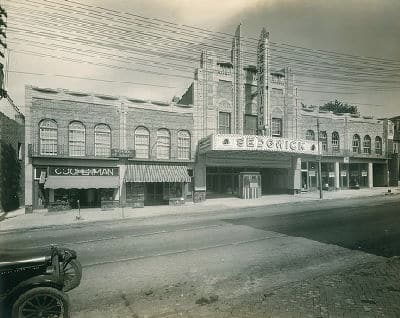The Sedgwick Theater: Preserving Historic Art Deco Design
The Sedgwick Theater, located in the charming Mt. Airy neighborhood of Philadelphia is a true gem of American history. Built in 1928 and designed by the esteemed architect William Harold Lee, this historic theater stands as a testament to the golden age of cinema and live performances. With its art deco design and grandeur, the Sedgwick Theater has captured the hearts of locals and visitors alike.
A Glorious Architectural Masterpiece
The Sedgwick Theater is one of the remaining 20 theaters in Philadelphia that William Harold Lee designed, out of which only two are still open. This magnificent building showcases the architectural style of the 1920s known as art deco, which was popular during the era of silent films and the advent of talkies. It was a time of great innovation in the film industry, and the Sedgwick Theater was designed to accommodate both silent films and synchronized sound productions.
The theater’s design originally included a balcony, but it was removed from the plans before construction. This modification gave rise to the theater’s vaulted ceilings, adding a touch of grandeur and spaciousness to the overall ambiance. As you step inside the Sedgwick Theater, you’ll be transported back in time to an era of glamour and excitement.
The Interior Design: A Feast for the Eyes
The moment you enter the Sedgwick Theater, you’ll be greeted by a rectangular lobby space where tickets were once purchased. Beyond this initial lobby lies a larger oval lobby with a convenient coat check. The oval lobby serves as a pivot point for the entire theater, with the theater’s footprint extending back and to the left from this central space.
As you make your way through the theater’s five large archways, you’ll notice the gradual drop in the rake of the seats, leading your gaze towards the screen located approximately 15 feet below. This clever design ensures that every seat in the house offers an unobstructed view of the action unfolding on the screen or stage.
From Glory to Neglect: The Theater’s Operating History
When the Sedgwick Theater opened its doors in 1928, it quickly became a beloved entertainment venue for the Philadelphia community. For nearly four decades, the theater showcased a wide range of films and live performances, captivating audiences with its charm and allure. However, as with many historic buildings, the Sedgwick Theater eventually faced a period of neglect and decline.
In 1966, the theater closed its doors and was subsequently purchased for use as a warehouse. The building was divided in two, with a cinderblock wall separating the theater space from the lobbies. The seats and rake were removed, leaving behind a gutted box at the back. Despite the damage, remnants of the theater’s former glory still remain, including a beautiful art deco ceiling medallion and part of the proscenium arch.
A New Chapter: Restoration Efforts
In 1995, David and Betty Ann Fellner purchased the Sedgwick Theater with a vision to restore it to its former glory. They established the Sedgwick Cultural Center, a not-for-profit organization dedicated to building community through the arts. A stage was constructed in the oval lobby, and performances have been held in this space ever since.
Despite their efforts, by 2006, the condition of the theater had not significantly improved, leading to the separation of the Sedgwick Cultural Center from the building. Restoration of the Sedgwick Theater comes with a hefty price tag, estimated to be around $10 to $12 million. This figure does not include the cost of creating a sustainable business within the theater to ensure its long-term viability.
A Hub of Community Art
Before 2010, the Sedgwick Theater served as a vibrant community art space, featuring a gallery where the ticket booth once stood. It occasionally hosted “Films at the Sedgwick,” providing a platform for the community to engage with films and take part in the programming. To minimize risks associated with screening films, the initiative focused on public domain films and encouraged community involvement in selecting the movies to be shown.
In May 2010, a classical repertory troupe called the Quintessence Theatre Group began renting the Sedgwick Theater. They breathed new life into the theater by staging productions such as Measure for Measure, captivating theater enthusiasts with their exceptional performances. As of September 2019, the Quintessence Theatre Group remains the sole occupant of the Sedgwick Theater.
The Enchanting Organ
When the Sedgwick Theater first opened its doors, it boasted a magnificent Möller pipe organ, known as Opus 5230. However, when the theater closed in 1966, the organ was removed and placed in storage. After more than two decades, the organ found a new home in the Keswick Theatre.
Preserving Philadelphia’s Cultural Heritage
The Sedgwick Theater is not merely a building; it is a symbol of Philadelphia’s rich cultural heritage. Efforts to restore and revitalize this architectural masterpiece are ongoing, driven by a shared passion for preserving history and creating a vibrant community space. With the support of dedicated individuals and organizations, the Sedgwick Theater has the potential to once again become a thriving hub of artistic expression.
As you explore the streets of Mt. Airy, Philadelphia, take a moment to appreciate the Sedgwick Theater’s grand facade and imagine the magic that once unfolded within its walls. This historic gem serves as a reminder of the power of art and the importance of preserving our cultural heritage for generations to come.
